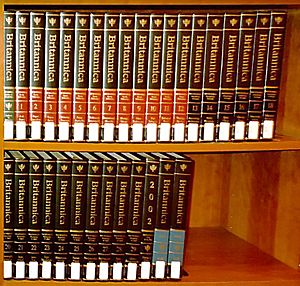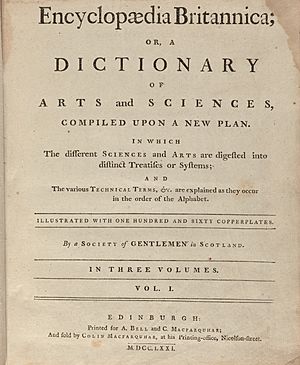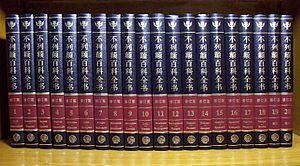Encyclopædia Britannica facts for kids

15th edition of the Britannica. The initial volume with the green spine is the Propædia; the red-spined and black-spined volumes are the Micropædia and the Macropædia, respectively. The last three volumes are the 2002 Book of the Year (black spine) and the two-volume index (cyan spine).
|
|
| Author | As of 2008[update], 4,411 named contributors |
|---|---|
| Illustrator | Several; initial engravings by Andrew Bell |
| Country |
|
| Language | British English |
| Subject | General |
| Published |
|
| Publisher | Encyclopædia Britannica, Inc. |
|
Publication date
|
1768–2010 (printed version) |
| Media type | 32 volumes, hardbound (15th edition, 2010); after 2012 unavailable in print |
| Pages | 32,640 (15th edition, 2010) |
| ISBN | 978-1-59339-292-5 |
| 031 | |
| LC Class | AE5 .E363 2007 |
| Text | Encyclopædia Britannica at Wikisource |
The Encyclopædia Britannica is a very famous encyclopedia. Its name means "British Encyclopedia" in Latin. It was first printed on paper in many books. Later, it also became available on computers and online. Since 2012, you can no longer buy the printed version. Now, it's mostly found online.
The Britannica is known for being very detailed and accurate. Many people think it's one of the best encyclopedias. It's the largest printed encyclopedia in English. The articles inside are arranged in alphabetical order, just like a dictionary.
When it first started in 1768, the Britannica only had three books. Over time, it grew much bigger. The last printed edition, called the 15th edition, began in 1974. It had 29 books, plus two indexes. These books were divided into the Macropædia (for longer articles) and the Micropædia (for shorter articles). There was also a special book called the Propædia that helped organize all the knowledge.
The articles in the Britannica are written for grown-ups. About 100 full-time editors and over 4,000 experts help write them. The Britannica is the oldest English-language encyclopedia still around today. It first came out in Edinburgh, Scotland, between 1768 and 1771. It quickly became very popular.
Contents
The Story of Britannica
The Britannica has been owned by many different people and companies over the years. These include Scottish publishers and American businesses like Sears Roebuck. Today, Jacqui Safra, a rich person from Switzerland, owns the company that makes Britannica.
As technology improved, people started using electronic encyclopedias more. Examples include Microsoft Encarta and Wikipedia. This meant fewer people wanted to buy printed encyclopedias. To keep going, Encyclopædia Britannica, Inc. made the encyclopedia cheaper. They also created computer versions on CD-ROMs, DVDs, and the World Wide Web.
Different Editions
There have been 15 main editions of the Britannica. Some editions also had extra parts added to them. For example, the 10th edition was an extension of the 9th edition. The 15th edition was changed and updated in 1985. This updated version is the one we know today.
Throughout its history, the Britannica always wanted to be a great reference book. It also aimed to help people learn new things. The 15th edition had an extra goal: to bring together all the knowledge that people have. The history of the Britannica can be split into five main periods.
The First Years (1768–1826)
In its early days, the Britannica was managed by the people who first created it. These were Colin Macfarquhar and Andrew Bell, along with their friends. The first Britannica was published in Edinburgh, Scotland. It was called Encyclopædia Britannica, or, A dictionary of arts and sciences, compiled upon a new plan. It was made to be like the French Encyclopédie.
The Britannica's logo shows a thistle, which is the national flower of Scotland. This showed that it was a Scottish business. Creating the Britannica was a big event during the Age of Enlightenment in Scotland, a time when many new ideas and inventions came about.
The first edition had only three books and was mostly written by one young editor, William Smellie. Some people said the first edition had mistakes. But slowly, the Britannica grew. By the end of this period, it had 20 books and many different people helping to write it.
The Second Period (1827–1901)

During this time, the Britannica was owned by a company in Edinburgh called A & C Black. More and more people wanted to help write for the Britannica because it was becoming very successful. These writers came from many countries. Some were very famous for their knowledge.
An index was added to the 7th edition to help people find articles easily. This index continued to be part of the encyclopedia until 1974. The first British chief editor was Thomas Spencer Baynes. He led the creation of the famous 9th edition, which was known as the "Scholar's Edition." Many people believe the 9th edition was the most academic Britannica ever written.
The Third Period (1901–1973)
In this period, American people owned the Britannica. They started to advertise a lot to earn more money. The American owners also made the articles simpler so that more people could understand them. Many say the 11th edition is the best edition of the encyclopedia. Its owner, Horace Everett Hooper, worked very hard to make it perfect.
Later, the Britannica was managed by Sears Roebuck for about 18 years. In 1932, Elkan Harrison Powell owned the Britannica. In 1936, he started a new system: articles would be checked and updated often. This was a big change. Before, articles were only updated when a new edition came out, which was about every 25 years.
In 1943, William Benton took over the Britannica until he passed away in 1973. He also set up the Benton Foundation, which managed the Britannica for many years. In 1968, the Britannica celebrated its 200th birthday!
Britannica Today
Since 1985, the Britannica has been divided into four main parts. These are the Micropædia, the Macropædia, the Propædia, and a two-book index. The articles are in the Micropædia and Macropædia. The Micropædia has 12 books, and the Macropædia has 17 books. Each book has about a thousand pages.
The Macropædia has 699 very detailed articles. These articles can be from 2 to 310 pages long. They often include references and the names of the writers. The Micropædia has about 65,000 shorter articles. Most of these are less than 750 words. They are good for quickly checking facts. For more detailed information, people use the Macropædia. The longest article is about the United States, which is 310 pages long!
To find information, you can use the index or the Propædia. The Propædia has an "Outline of Knowledge" that tries to organize everything people know. This outline helps the editors decide what articles to include. It can also be a study guide for students who want to learn a topic deeply.
In total, the Micropædia and Macropædia have about 40 million words and 24,000 pictures. The index has 2,350 pages and lists over 228,000 topics. The Britannica uses British English spellings, like colour instead of color.
Since 1936, the articles in the Britannica have been updated often. About 10% of the articles are rewritten each year. This means the information stays current.
The articles are arranged in alphabetical order. If articles have the same name, articles about people come first, then places, then things.
Other Britannica Versions
Printed Books
There are also smaller versions of the Britannica. The Britannica Concise Encyclopædia is one book with 28,000 shorter articles. Compton's by Britannica was published in 2007. It's for teenagers aged 10–17 and has 26 books.
A Children's Britannica was published in 1960. There's also My First Britannica for younger children (6–12 years old). The Britannica Discovery Library was for very young children (3–6 years old).
Since 1938, Encyclopædia Britannica, Inc. has published a Book of the Year every year. This book has information about events from the past year. It's been available online since 1994.
Digital Versions
The Britannica Ultimate Reference Suite 2006 DVD had over 55 million words and 100,000 articles. It included articles from the main Britannica, plus articles from the Britannica Student Encyclopædia and Britannica Elementary Encyclopædia. It also had maps, videos, sound clips, and web links. It even included a dictionary and thesaurus from Merriam-Webster.
Encyclopædia Britannica Online is a website with over 120,000 articles. It's updated often and includes daily news from The New York Times and the BBC. You usually need to pay to use the website. However, sometimes you can read articles for free if you find them through a search engine.
In 2007, Encyclopædia Britannica, Inc. worked with a mobile phone company called AskMeNow. This allowed users to send a question by text message and get an answer from Britannica's encyclopedia on their phone.
In 2008, there was an idea to create a wiki-Britannica. This would let many people help write and edit articles, with the Britannica staff checking the important parts.
Images for kids
See also
 In Spanish: Enciclopedia Británica para niños
In Spanish: Enciclopedia Británica para niños









